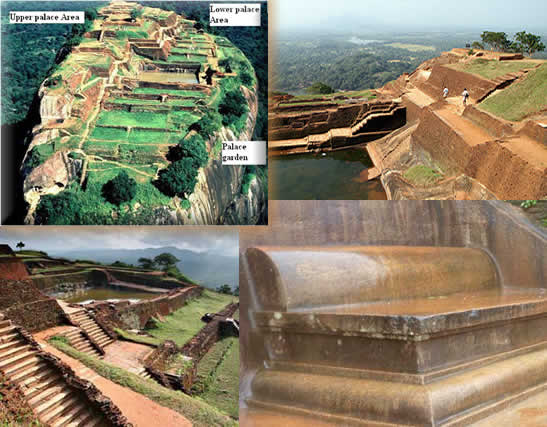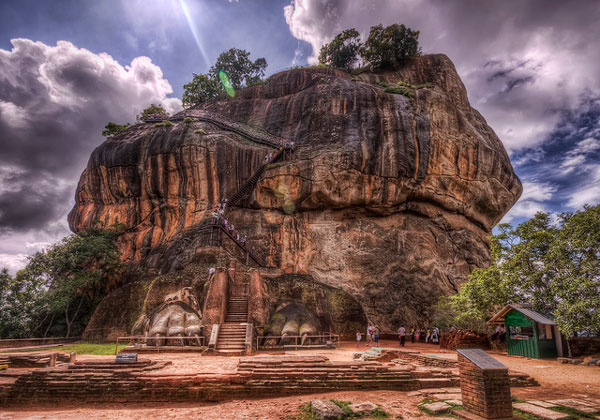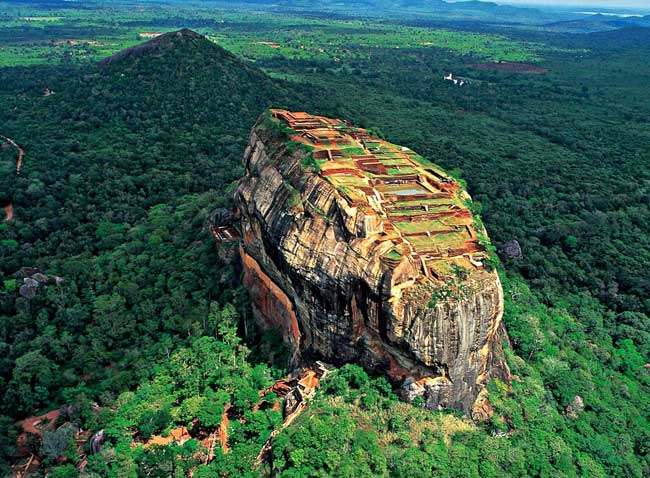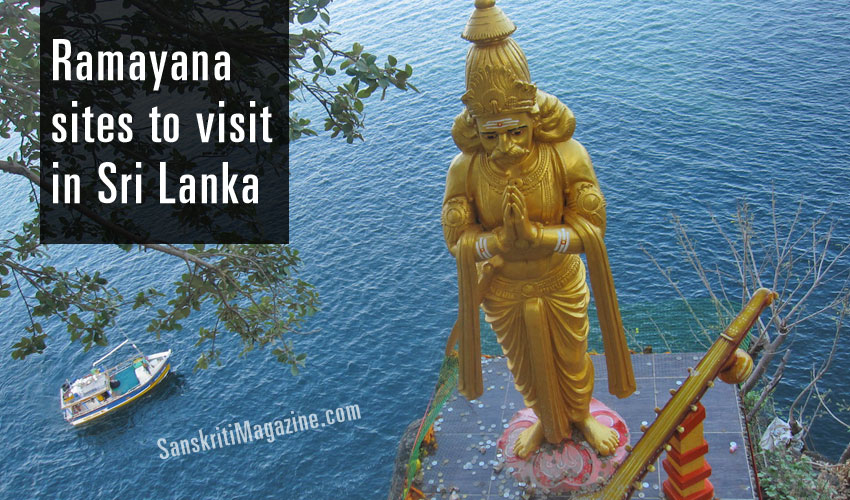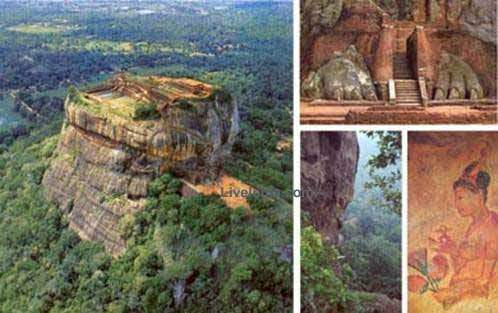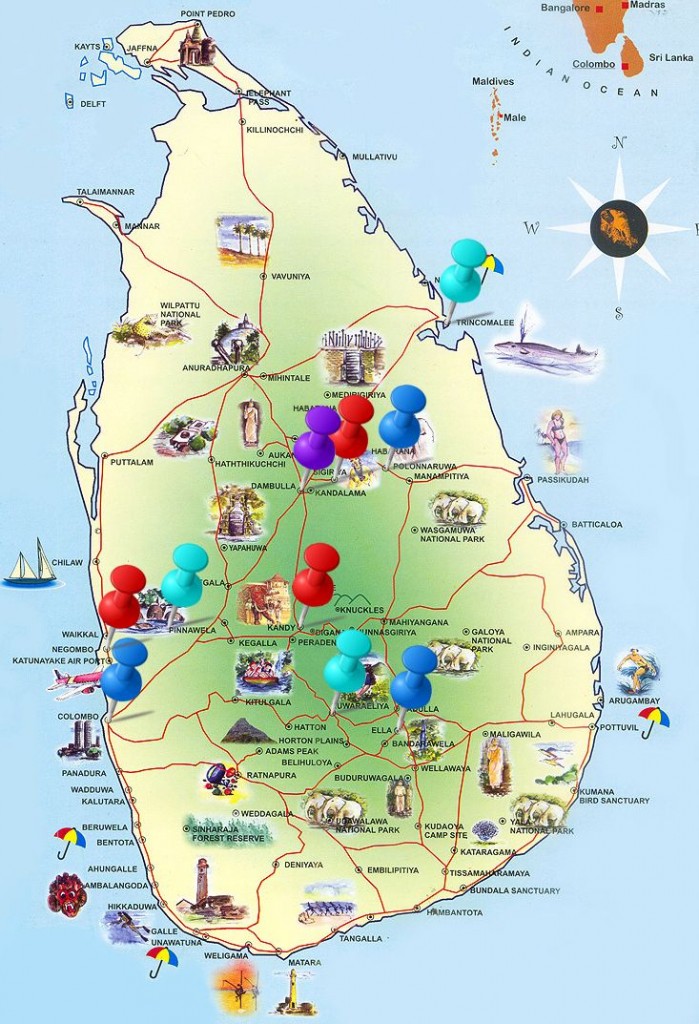 Although Ramayana happened millennium ago, it has geographical traces from North to South India, and more specifically in Sri Lanka.
Although Ramayana happened millennium ago, it has geographical traces from North to South India, and more specifically in Sri Lanka.
Apart from Rama Setu (Adam’s bridge) between Dhanuskodi and Sri Lanka, one can find many other sites.
According to Valmiki Ramayana, Ravana brought Sita Devi from India in a Pushpaka Vimana which is widely known in Sri Lanka as the “Dandu Monara Yanthranaya,” or Large Peacock Machine in Sinhalese.
Few people do not like to believe that the present Sri Lanka is the Lanka mentioned in the Ramayana, but we find that there is still much convincing tradition therein and many sites identified with the Ramayana’s Sundara Kanda and Yuddha Kanda.
There are more than 50 sites in Sri Lanka, which are mentioned in Ramayana, from the place of Sita ’s captivity to the battlefields where both armies clashed, to the groves of exotic herbs dropped by Hanuman, to the ultimate place of war where Lord Rama slew Ravana.
An oath taken at the spot where Sita Devi undertook “Agni Pariksha” is still considered valid in village courts or grama sabhas.
The color of the soil of the ancient battlefield is still red today, and is still surrounded by lighter colored earth. One of the airports of Ravana, torched by Hanuman when he came looking for Sita , still has a scorched-earth look. A patch of darker soil surrounded by brown earth.
Exotic alpine Himalayan species are found suddenly amidst tropical Sri Lankan vegetation, the legacy of Hanuman’s heroic voyage carrying a mountain with life-restoring herbs called Sanjeevani.
What is more incredible is that the names of places have come down to modern times unchanged.
Ravana, using a golden deer as a decoy, visited Sita when she was alone. In the guise of an old sage, he abducted and brought her to Weragantota in Lanka in his plane, the Pushpaka vimana.
Weragantota means the “place of aircraft landing” in Sinhala. This is the first place Sita was brought to Lankapura (capita city of king Ravana). These jungles are the place where the city of Lankapura once stood. The city had a beautiful palace for Queen Mandodari surrounded by waterfalls, streams and varieties of flora and fauna. Sita was kept at Queen Mandodari’s palace at Lankapura.
Place Sita was held captive is called Sita Kotuwa, which means “Sita ’s Fort” in Sinhala.
Ravana had an aircraft repair center at Gurulupotha close to Sita Kotuwa.
In Valmiki’s depiction, King Ravana’s vimana resembled a huge peacock. The vimana in Sinhala language means “Dhandu Monara” which is known as “flying peacock,” and hence the name Gurulupotha, which means “parts of birds” in Sinhala. This is also called Gavagala.
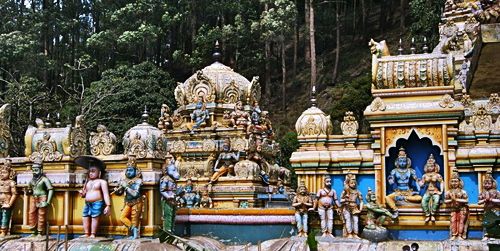
Sita Amman Temple in Nuwara Eliya (Asoka Vatika)
Nuwara Eliya is home to the Sita Amman temple, which has a stream by the side. It is believed that Sita Devi bathed in this stream. It is also interesting to note that foot prints akin to Lord Hanuman’s are found on the rocks along this river and some are of small size and some are of larger size which indicates the power of Lord Hanuman transforming himself into any size.
The barren land atop of a mountain range isthe route in which King Ravana took Sita devi from his capital city Lankapura to Asoka Vatika.
The Chariot Path atop the mountain range is still visible. Till date no vegetation grows on this passage except grass.
About a century ago three images were discovered in the stream, one of which was that of Sita. It is believed that the deities have been worshipped at this spot for centuries. Now there is temple for Lord Rama, Sita devi, Lakshmana, and Hanuman by the side of this stream.
The summit of the mountain next to the mountain range overlooking Frotoft Estate in Pussallawa is the place where Hanuman first set his foot on mainland Lanka. This mountain known as Pawala Malai is visible from this mountain range.
These hills stand tall in-between King Ravana’s capital city and Asoka Vatika.
The Sita tear pond is found en route by the chariot route, and is believed to have been formed by the tears of Sita devi. It has not dried up since, even during severe droughts when the adjoining rivers dry up. Visitors could also see the famed Sita Flowers (Saraca asoca) which are endemic to this area.
The peculiarity of these flowers is the configuration of the petal’s, stamen and pistils, which resemble a human figure carrying a bow, and is said to represent Lord Rama. These flowers are unique only to this area in the whole of Sri Lanka.
While crossing the ocean, Hanuman was tested by Surasa Devi, the Naga maiden en-route to Lanka. This place is now called Nagadipa.
When Hanuman chose to get captivated to Meghnaad (son of Ravana), as a punishment, his’s tail was set on fire. Hanuman in turn set fire to the houses in the city. Ussangoda is one such torched area.
On the way back to India Hanuman rested at Mani Kattuthar.
Nearby, there is a village called Kondagala, known as Kondakalai in Tamil, where Sita is said to have deranged her hair whilst passing the place. Kondakalai (Kondagala), like many other cities and villages in Sri Lanka, also derives its name from the Ramayana. When King Ravana took Sita devi in a chariot to Asoka Vatika, her hairs got deranged because of the speed of the chariot. “Konda kalai” in Tamil means “deranging of hair.”
This village also contains Sita Goli (Gooli) which are rice balls offered by Ravana to Sita; which she refused and threw away. When King Ravana carried Sita devi on his chariot to Asoka Vatika, he provided her with vitaminized rice balls for refreshment. But Sita devi who did not want to consume anything provided by King Ravana, scattered the rice balls all over the place during her journey, and they are found till date along the chariot track. The local people call these rice balls Sita Goli and they prescribe them for their children as a cure for stomach disorders and headaches. The farmers too keep them in their cash boxes or grain pots for prosperity. It is claimed that carbon dated testing has been done in Tokyo and Delhi on these rice balls and ascertained them to be more than five thousand years old.
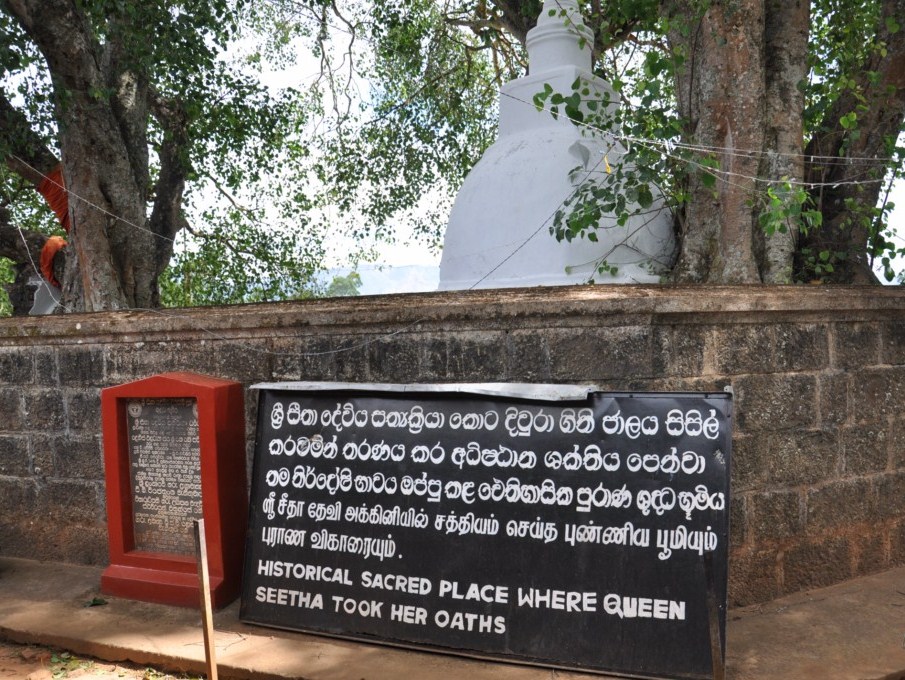
Sita hiding place after Hanuman’s visit
After Hanuman visits Sita , burns half of lanka and leaves, Ravana plans to shift Sita and hide her for a while.
Ravanagoda, which means Ravana’s place in the Kotmale area, is one such complex of tunnels and caves.
Istripura is another ingenious network of paths which are interconnected with all major areas of king Ravana’s city. Istripura means “Area of Women” in Sinhala. This refers to the retinue of ladies Ravana made available to look after Sita .
Konda Kattu Gala refers to the many intruding tunnels and caves in this area. This seems to be a part of a great ingenious network of paths, which is interconnected to all the major areas of King Ravana’s city. Sita devi took bath in this very stream and had dried her hair sitting on a rock and put clips to her hair, hence this rock is known as Konda Kattu Gala. This is situated in the Welimada Area.
A close look at these tunnels indicates that they are man-made and not natural formations. The Buddhist shrine at Kalutara was once where King Ravana’s palace and a tunnel existed. Additional existing tunnel mouths are situated at Welimada, Ravana cave at Bandarawela, Senapitiya at Halagala, Ramboda, Labookelle, Wariyapola/Matale, and Sitakotuwa/Hasalaka, along with many more tunnels. Some have also said that Ravana had a tunnel that went all the way to South America, in which he had stored much of his gold and treasury.
He also chose this path to meet his brother Ahiravan, who lived in Paatala Loka (Brazil).
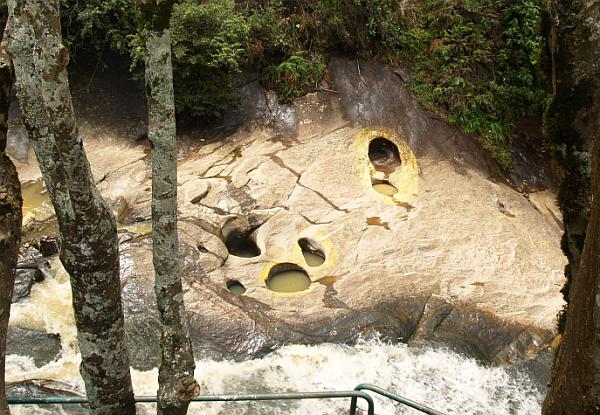
Gayathri Peedum is the place from where King Ravana’s son Meghanad propitiated Lord Siva with penance and pujas, and in turn was granted super natural powers by Lord Siva prior to the battle. Neelawari is located in the North of the country in the Jaffna peninsula and is where Lord Rama shot an arrow to the ground to obtain water for his army upon arriving at Lanka.
Dondra, Seenigama & Hikkaduwa are places in the South of Lanka where Sugriva (king of Vanaras) prepared for his war on King Ravana’s forces from the Southern flank.
During the battle, Meghanad beheaded a lookalike of Sita Devi to break spirit of opponents. This place is known as Seethawaka in the Avissawella area.
Yudhaganawa, meaning battlefield in Sinhala, is a place in Wasgamuwa where the major battles took place.
Upon being hit by Indrajit (Meghanad)’s Brahmastra, both Rama, Lakshmana lay unconscious on the battle field. To cure them, Jambavan the veteran monkey instructed Hanuman to go to Sanjeevani Parvatha, the hill of herbs between Rishhaba and Kilasa peaks in the Himalayas and bring the necessary medicinal herbs. As he could not identify which herbs to select, Hanuman uprooted the entire peak with all the herbs growing there from the mountain and returned to Lanka.
Parts of the hill fell on five places in Sri Lanka; namely Rumassala in Galle, Dolukanda in Hiripitiya, Ritigala close to Habarana on the Habarana Anuradhapura road, Talladi in Mannar, and Katchchathivu in the north.
Lord Karthikaya Subramaniyam was requested to go to battle by Lord Indra to protect Lord Rama from king Ravana’s Brahmastra. This was at Kataragama, which is now a very popular place for worship among Sri Lankans.
End of Ramayana War and afterwards…
Dunuvila lake is a place from which Lord Rama fired the Brahmastra arrow at king Ravana who was directing the war from Laggala. It is here that King Ravana was killed by Lord Rama’s brahmastharam. The top of Laggala is flat and is believed to have been affected by the power of the brahmastharam. “Dhunu” means “arrow” and “Vila” means “Lake,” so it gets its name from this pastime.
The name Laggala is derived from the Sinhala term “Elakke Gala“, which means Target Rock. Laggala served as a sentry point to observe Lord Rama’s army. The cartels behind the Dunuvila lake are called Laggala. It was from this rock the first glimpse of Lord Rama’s army was sighted and informed to King Ravana. This hill is geographically the highest part of the northern region of King Ravana’s city and on a clear day the north east side that is Thiru Koneshwaran and north west side that is Talai Mannar can be seen even today. King Ravana is believed to have done meditation on this rock and prayed to Lord Siva at Thiru Koneshwaran from this point.
After Ravana’s death, his body was kept at Yahangala, meaning “Bed Rock” in Sinhala. This is situated along the Mahiyanganaya – Wasgamuwa road. King Ravana’s body was kept upon this rock so his countrymen could pay their last respects to their dear departed king. Geographically this rock is visible from miles away on its 3 sides.
Sita met Rama after the war, and at Divurumpola, she under went the “Agni” test of fire where she proved her innocence and purity to Rama. Divurumpola means the “Place of Oath” in Sinhala. She came out unscathed to proved her innocence and purity.
Vantharamulai is a place that Lord Rama, Sita, Lakshmana, and Hanuman rested after the turmoil of the war. Amaranthakali is the place where they had the first meal after the war.
Rama installed first Siva Lingam at Munneswaram, to get rid of ‘Brahma Hatya Dosham‘ (killing of a brahmin Ravana).
This was done at Manavari about 5 Km from Munneswaram, near the banks of Deduru Oya.
Munneswaram means the first temple for Siva (Munnu + Easwaran).
After his brother’s death, Vibhishana was coroneted as a king of Lanka by Lakshmana at Kelaniya. This is the closest site to Colombo connected to the Ramayana.
Vibishana is considered one of the four guardian deities of Sri Lanka, and temples for Vibishana are found throughout Sri Lanka. A painting of King Vibishana also adorns the new Parliament of Sri Lanka. In fact, there are no temples dedicated for Ravana, but many exist for Vibishana; this goes to prove that his stand towards Vedic Dharma & justice made people to revere him as a god in Sri Lanka.
Vibishana is also a Chiranjeevi (1 among 7 immortals in this chaturyuga), and is believed to be ruling the submerged Lanka till end of this creation.
Kelani River is mentioned in the Valmiki Ramayana and Vibishana’s palace was said to be on the banks of this river.
In addition to above, there are many Ramayana sites in Sri Lanka like :
- Thotupolakanda (“Mountain Port” in Sinhala) at Horton plains
- Weragantota (“Place of Aircraft” landing in Sinhala) in Mahiyangana
- Ussangoda (“Area of Lift” in Sinhala) in the Southern coast
- Wariapola (“Aircraft Port” in Sinhala) in Matale and Kurunagala.
